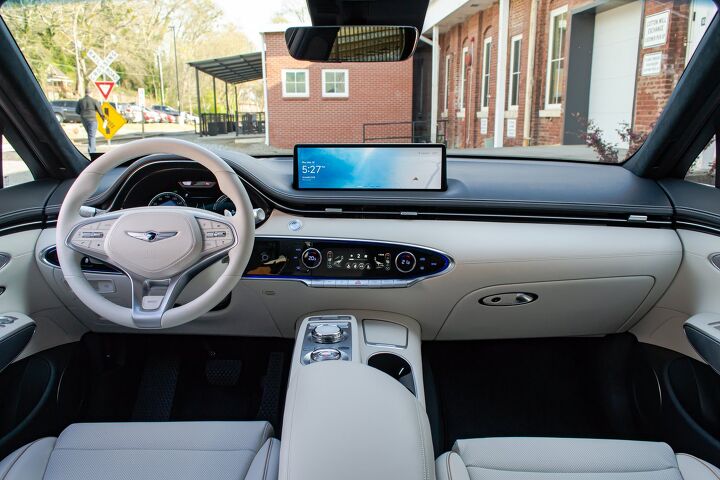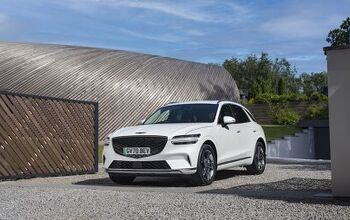2023 Genesis Electrified GV70 Review: First Drive


FAST FACTS
| Motor: | 2x permanent-magnet synchronous motor |
| Battery Capacity: | 77.4 kWh |
| Output: | 483 hp, 516 lb-ft) |
| Transmission: | 1AT, AWD |
| US fuel economy (MPGe): | 98/83/91 |
| CAN fuel economy (Le/100KM): | N/A |
| Range: | 236 mi / 383 km |
| Starting Price (USD): | $66,975 (inc. dest.) |
| As-Tested Price (USD): | $73,225 (inc. dest.) |
| Starting Price (CAD): | $84,000 (inc. dest.) |
| As-Tested Price (CAD): | $84,000 (inc. dest.) |
Genesis doesn’t believe in half-measures. The Korean luxury brand has famously skipped out on electron-assisted ICE models, going straight from gas to fully electric.
It’s doing it with a quickness too, as this 2023 Genesis Electrified GV70 is the brand’s third EV in less than a year. As the name implies, this take on the brand’s compact SUV tears out the gas powerplants and drops in an electron-munching one.
There are two questions that the GV70 must answer. First, does it keep the regular GV70’s excellent reputation as a luxurious, pampering SUV? And beyond that, can the EV justify its extra cost? I spent a day driving it around the Atlanta area to find out.
Get a Quote on a New 2023 Genesis GV70What’s new?
Alright, so what exactly has changed here? The E GV70, as I’m now going to call it, is something of a fancy-pants Frankenstein. The platform is the same one underpinning the ICE model, which was built to handle both propulsion styles. However, it’s the baby brother GV60 that lends its 77.4-kWh battery pack and twin 160 kW motors, one at each axle. Combined horsepower is the same 429 hp as the GV60 Performance, along with the same instant-access 446 pound-feet. There are no other battery or motor options.
SEE ALSO: Genesis GV60 vs Volvo C40 Comparison: High-Style EV Face-OffThere aren’t a whole lot of visual changes to mark out the electron-munching GV70. The surest signs are the lack of tailpipes out back and the filled-in, reverse G-Matrix “grille” up front, which hides the nose-mounted charge port. The keen eyed might notice the tweaked bumpers at either end, or the unique-to-Electrified 20-inch alloy wheels. If you’re in America, a quartet of monochromatic exterior paint options means any actual color points to a gas engine. Canada gets double the choices, including a bright red and dark blue.

I’m happy to report there’s not much different inside the E GV70 either. This is the same luxurious cabin as the gas model, though it’s done up in some unique materials. The Electrified model offers up an exclusive Glacier White leather interior, and the top Prestige trim (one of two in the US, and the only one in Canada) adds this subtly fancy copper contrast piping.
What’s it like to drive?

I’m a fan of the gas GV70 driving experience, especially the athletic 3.5T Sport Prestige (Sport Plus in Canada). The Electrified’s wider tires—265s versus 255s—might suggest an even more engaging drive, but the truth lies in the careful trim selection here. The Prestige is a more rounded offering, dialling back the pointy nature for a smoother, more measured drive.
SEE ALSO: Genesis GV70 vs BMW X3 Comparison: Compact Luxury Face-OffThe GV70 stays level through the corners, the low-slung battery pack seeing to it. Pitch and roll are kept in check, and the typically light steering is accurate. The electronically controlled suspension uses a road preview feature that scans the path ahead and adjusts in advance, smothering bumps. Like the Electrified G80 before it, the E GV70 works best as a luxury ride first. Sure, you can switch into Sport mode and chuck it at a winding road without the SUV tripping over itself, but the Electrified GV70 feels more comfortable when taking a laidback approach. Here, its excellent sound deadening and well-damped ride make for a calm, relaxing experience.

Genesis doesn’t publish acceleration times. That being said, the seat-of-the-pants feel suggests this is very much the quickest GV70 in a straight line. Those 429 electric ponies shove the GV70 down the road with authority. Like the GV60, there’s also a Boost Mode button, sitting at the six-o’-clock position on the steering wheel. This unlocks an extra 54 horsepower in 10-second bursts, with technically no cool down time. It’s a solid push in the back, though it doesn’t feel quite as rabid as the smaller, lighter GV60.
There is a proper one-pedal drive mode (called i-Pedal), along with selectable levels of regenerative braking. The hand-off between regen and friction braking is smooth.
SEE ALSO: 2023 Genesis Electrified G80 First Drive Review: Goodbye GasCabin comfort

It’s been nearly two years since we first experienced the GV70, and the Electrified’s newly reskinned cabin still impresses. The design and material choices all feel special, from the jewellery-like switchgear to the soft Nappa leather. Primary climate controls are easy to reach, though the touchscreen functions for seat temp and fan speed are a little too, well, little.
The EVification has done little to alter the available space. Second-row legroom is down by about two-thirds of an inch, and trunk space is fractionally smaller; we’re talking two cartons of milk or so.
SEE ALSO: 2022 BMW iX xDrive50 Review: Flagship For a New Era
Electrified GV70 buyers will find a well-stocked model, as even the Advanced trim comes with heated and ventilated seats, the electronically controlled suspension, tri-zone climate control, pano sunroof, and leather seating. A full suite of driver assistance features is standard too, including the latest Highway Driving Assist 2.0, which can now make lane changes (provided you activate the option in the menu). Prestige models slather on a head-up display, the 3D digital instrument panel, Lexicon sound system, Active Noise Control, and more.
2023 Genesis Electrified GV70 Review: Charging speeds and range

The Electrified GV70 uses the same 800-volt architecture as other Genesis models. This allows it to pull off the standard 10–80 percent state of charge measurement in as little as 18 minutes when hooked up to a DC fast charger, at a max rate of 240 kW. Genesis says a 5-minute charge could add as much as 64 miles (103 kilometers), again, in optimal conditions. A full charge on a 240-volt Level 2 setup takes around 7 hours.
Also like the other Genesis EVs, the GV70 comes standard with vehicle-to-load (V2L) capability, allowing owners to plug into either of the available outlets to supply up to 1.92 kW of power to accessories. V2L is available down to 20-percent SOC, and users can set a limit to automatically cancel V2L at certain charge thresholds.

Genesis quotes a single-charge range of 236 miles (383 kilometers). That’s quite a way’s shy of the Tesla Model Y, which offers more than 300 mi (483 km) in either trim, but more than the Lexus RZ I recently drove, which is quoted as low as 196 mi (315 km).
SEE ALSO: 2023 Lexus RZ 450e First Drive ReviewDollars and sense

The Electrified Genesis GV70 arrives in both Advanced and Prestige trims in America, and only the latter in Canada. The Advanced starts at $66,975 including destination, with the only additional costs being exterior paint selection. The Prestige bumps that sticker up to $73,775, again not including premium paints. Both models come with three years of complimentary 30-minute charging sessions from Electrify America. Genesis recently expanded EV sales into a total of 15 states.
In Canada, which uses an all-in pricing strategy, the Electrified GV70 is simply $84,000 CAD. The E GV70 is available in all provinces.
For those keeping score at home, the Prestige sits about seven or eight grand above the top-trim gas-powered GV70, depending on market. The Electrified GV70 will be eligible for incentives in the US as well, as it will be the first Genesis built in America. (Canadian models will still come from Korea.)

I asked Genesis Canada director Eric Marshall who the brand saw as natural competition for the E GV70. He turned the question right back at me; the implication being there aren’t a whole lot of options in this size class right now. The afore-mentioned Model Y and Lexus RZ are two—even if I’d argue the former isn’t luxury in any way—while the Cadillac Lyriq offers a similarly high-fashion electric experience, with the advantage of more range and power at the same price.
SEE ALSO: 2023 Genesis GV60 First Drive Review: Keep EVs WeirdFinal thoughts: 2023 Genesis Electrified GV70

The 2023 Genesis Electrified GV70 does exactly what it says it does: it takes a smooth, stylish, user-friendly luxury SUV and swaps in an all-electric powertrain. In that sense, it is very low on surprises—but that’s exactly what Genesis was aiming for, a great compact SUV that just so happens to be electric.
For those buyers still looking for the most dynamic experience, the gas-powered GV70 Sport, and even the smaller GV60, are the right choice. Those who want extra emphasis on the calm, quiet, and capable feel of luxury, will be served well with this latest member of the GV70 family.
FAQs
How much does the 2023 Genesis Electrified GV70 cost?
The Electrified GV70 Advanced starts from $66,975 in America, including destination. This tester is the Prestige, which rings in at $73,775 ($84,000 CAD).
When can you buy the 2023 Genesis Electrified GV70?
The all-electric GV70 is available for order now, in 15 states and all Canadian provinces.
How far can an Electrified GV70 go on electric?
The Electrified GV70 is capable of up to 236 miles (383 km).
Become an AutoGuide insider. Get the latest from the automotive world first by subscribing to our newsletter here.
LOVE IT
- Powerful and quick (including charging)
- Super comfortable seats and ride
- Simple trim lineup
LEAVE IT
- Pricey, especially without incentives in Canada
- Range is on the low side
- Not as fun to drive as the V6 Sport

Kyle began his automotive obsession before he even started school, courtesy of a remote control Porsche and various LEGO sets. He later studied advertising and graphic design at Humber College, which led him to writing about cars (both real and digital). He is now a proud member of the Automobile Journalists Association of Canada (AJAC), where he was the Journalist of the Year runner-up for 2021.
More by Kyle Patrick































Comments
Join the conversation